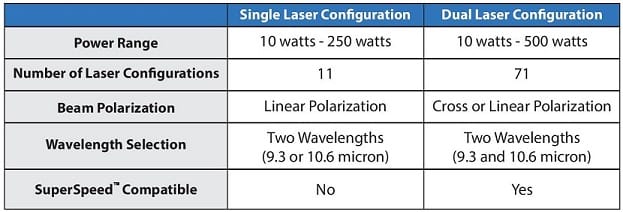Dual Laser Configuration
Universal Laser Systems (ULS) products are derived from an ecosystem of mutually-supportive and customer-oriented laser material processing technologies. They work together like cogs on a gear, perfectly meshing to provide each customer the optimal laser processing solution.
The patented Dual Laser Configuration from ULS is a fundamentally different approach to using multiple laser sources. The beam of each laser is combined within the platform, not on the lasers or in a separate assembly. Unlike other laser systems, this design provides multiple advantages to the customer:
- Expands Laser Material Processing Capability
- Improves Reliability
- Improves Laser System Performance
- Enables Other Unique Universal Features
- Protects and Optimizes Investment
Expands Laser Material Processing Capability
Polarization is used by ULS to combine multiple laser sources into a single beam, thereby dramatically increasing the available power range up to 500 watts. Additionally, systems equipped with two laser sources are able to combine lasers of different power levels and wavelengths. This feature is highly advantageous in laser material processing because both the rate of energy delivery along with the peak power are different for each laser power level. Wood, for example, tends to create more carbonization as it burns under lower power, producing a high-contrast mark. If a higher-power laser is used, there is less charring and less contrast. Both high- and low-contrast marks are useful when processing wood. For an extensive discussion on the benefits of using laser sources of differing power, see Rapid ReconfigurationTM.
Laser systems with Dual Laser capability offer more than six times the number of laser configurations. Each unique combination of laser power and wavelength offers the user an additional option for configuring the optimal laser materials processing solution for their application. The level of flexibility cannot be understated in its importance. Each of the following applications, for example, require a unique pair of laser sources to produce ideal results:
- Laser cutting thick materials: 2 x 75 watt 10.6µm lasers
- Precision cutting of thin materials: 2 x 10 watt 10.6µm lasers
- High-throughput raster marking: 2 x any laser power 10.6µm lasers with SuperSpeed™
- Laser marking and cutting of plastic: 1 x 30 watt 9.3µm laser and 1 x 75 watt 10.6µm laser
- Laser cutting and selective layer ablation of thin films: 1 x 10 watt 10.6µm laser and 1 x 30 watt 10.6µm laser
- Two-tone marking of wood: 1 x 10 watt 10.6µm laser and 1 x 75 watt 10.6µm laser
Number of Power and Wavelength Combinations Available
for Single and Dual Laser System Configurations
Improves Reliability
ULS manufactures high-quality laser sources that operate reliably for many years. However, all laser sources eventually require service. Dual Laser Configuration essentially eliminates downtime by providing an inherently redundant laser system. If one laser source requires replacement or repair, the other laser source can continue to operate. When the laser service has been completed, the laser can be re-installed and returned to its previous power output level.
Improves Laser System Performance
In laser cutting, engraving, and marking machines with Dual Laser Configuration, the combination of the two beams occurs within the system itself instead of in the carriage, as is the case with other laser systems (also known as laser cutters, laser engravers, or laser markers). This allows all ULS optical elements to be small and lightweight, thereby improving system performance.
From a laser materials processing perspective, linearly-polarized laser energy can cause asymmetric material interactions. For example, a linearly-polarized beam cutting through a material will often cut wider in one direction than in the other. Dual Laser Configuration leverages this effect, which allows users to install two lasers onto the same laser system and create a cross-polarized beam, producing consistent cut widths regardless of the direction of travel.
Enables Other Unique Universal Features
Dual Laser Configuration allows customers to maximize the utility of several other Unique Universal features and technologies such as SuperSpeed™, Multi-Wavelength™ and MultiWave Hybrid™ technologies, along with several features within the ULS software. Dual Laser Configuration also enhances the benefits of Rapid Reconfiguration by allowing two separate laser sources to be selected in parallel to one another on a single system. This technological ecosystem is indicative of the high degree of consideration that goes into the design and construction of all ULS products, with the goal of maximizing customer capability, flexibility, and profitability.
Protects and Optimizes Investment
Many customers start with a dual-laser system, but use only a single laser source. As time goes by and their business grows, they may purchase a second laser source to expand their range of laser material processing capabilities and/or increase productivity. With other laser systems, each new laser purchase diminishes the benefit of the laser sources that the customer already owns, since they cannot easily be reinstalled onto their system. However, this is not true with Dual Laser Configuration. A vast majority of laser sources purchased from ULS in the past maintain compatibility with ULS systems, meaning that a past investment in laser sources impacts the future by providing both long-term laser compatibility and virtually limitless possibilities for future laser system configurations.
A laser cutting, engraving, and marking machine equipped with Dual Laser Configuration also affords customers a high level of flexibility with their investment. For example, a customer can choose to purchase lasers of the same wattage or instead decide on mixed wattages, depending on the needs of their specific applications. With Dual Laser Configuration, they can choose the more economical option now, with full knowledge that a future upgrade is extremely easy and that the upgrade will not only provide a throughput advantage by combining both sources, but will also yield all of the processing advantages associated with having two laser sources.


